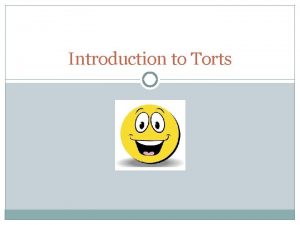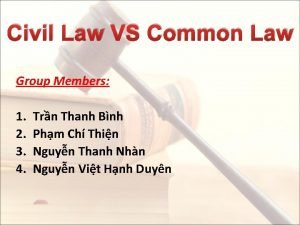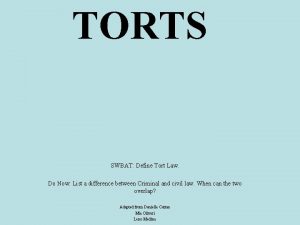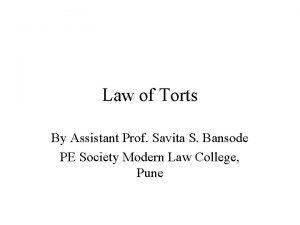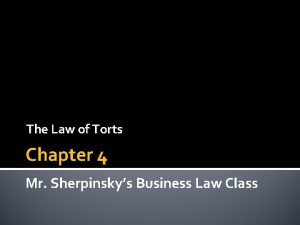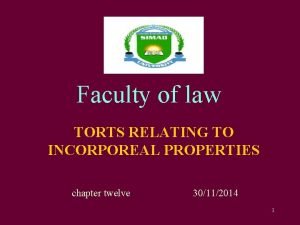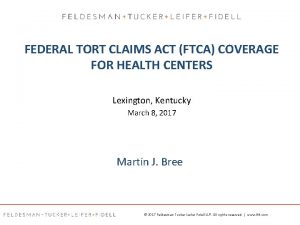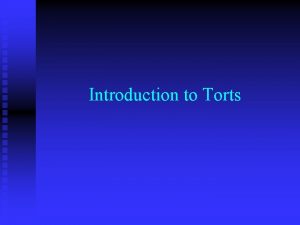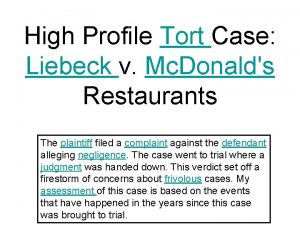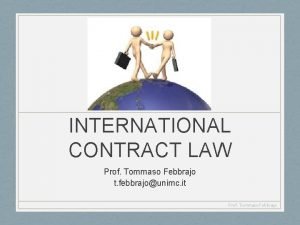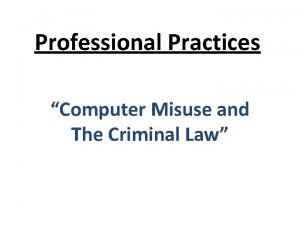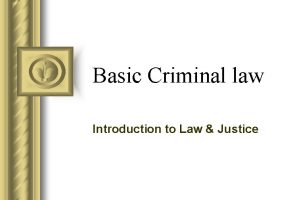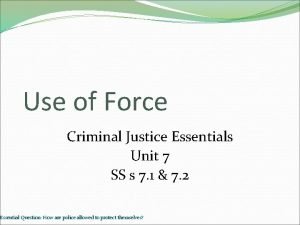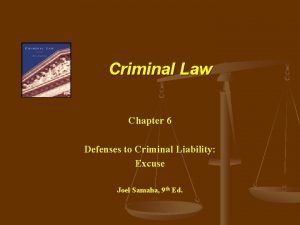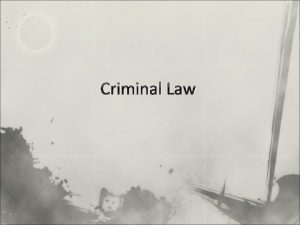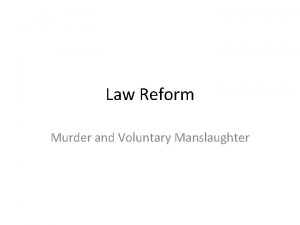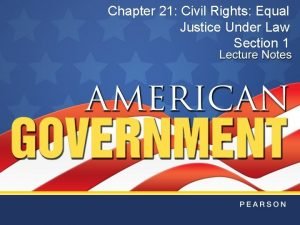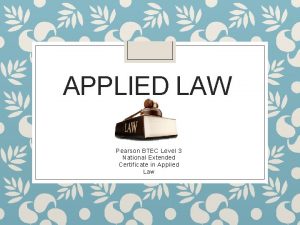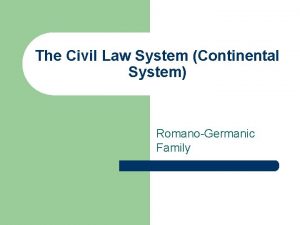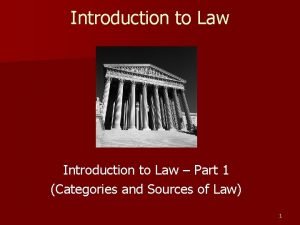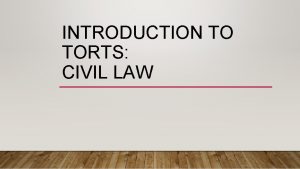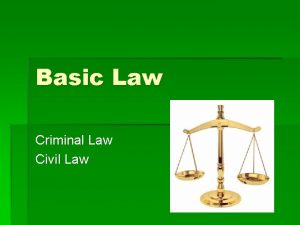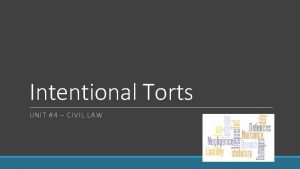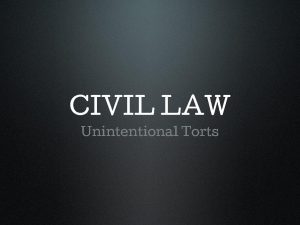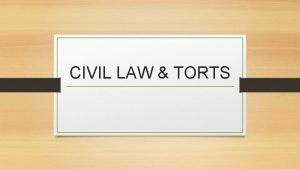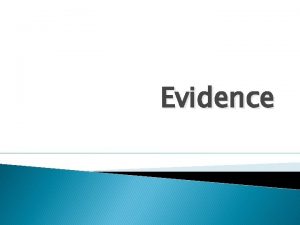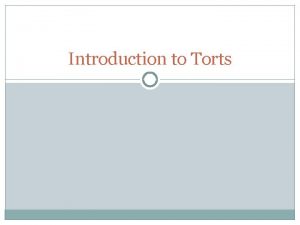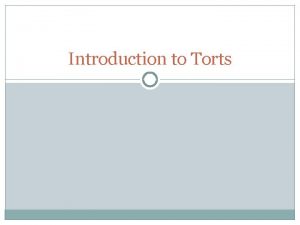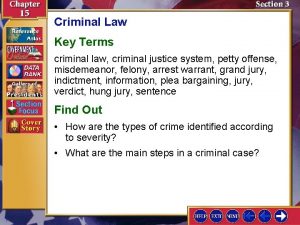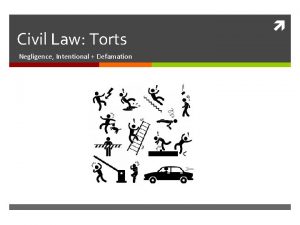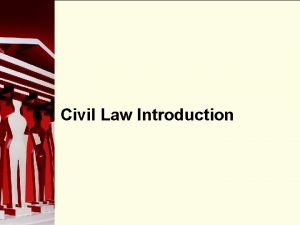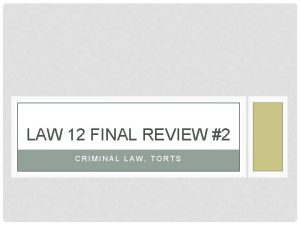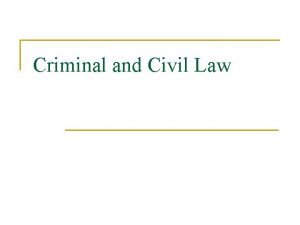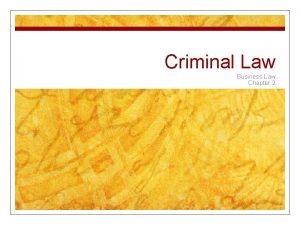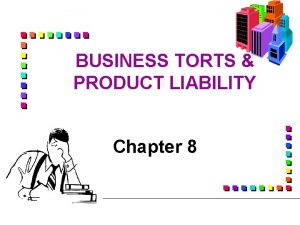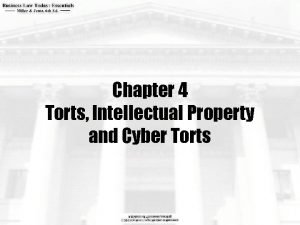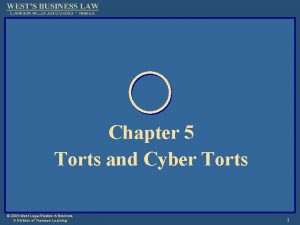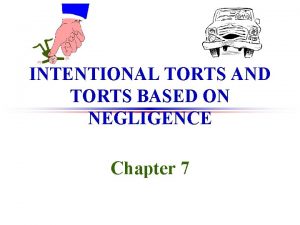INTRODUCTION TO TORTS Criminal Law v Civil Law










































- Slides: 42

INTRODUCTION TO TORTS

Criminal Law v. Civil Law Criminal Law - Plaintiff is the state (e. g. , party State v. Doe) Roe) - Plea Bargain - Guilty or Not Guilty - Guilty verdict results in prison sentence (i. e. , - Prosecution must prove guilt beyond a reasonable doubt or Civil Law - Plaintiff is private (e. g. , Doe v. -Settlement - Liable or Not Liable - Liability results in paying damages money) - Plaintiff only needs a preponderance of evidence (i. e. , 51% more)

Parties are called litigants (Litigation is the action) Plaintiff- party that initiated the legal action Defendant-litigant against whom the action is taken ie: Mc. Fadden v. Harris Onus is on the plaintiff to prove the case on a “balance of probabilities”-the weighing of evidence to decide whether it is the plaintiff’s or the defendant’s version of the events that is more convincing.

Types of Civil Cases Domestic Divorce, child support, custody and visitation, and division of the marital property. Contracts Disputes over an agreement usually for the payment of money for services or goods. Personal injury Action to recover damages (money) for injuries sustained due to someone else’s fault.

Definition of a Tort Black’s Law Dictionary defines a tort as 1. A civil wrong for which a remedy may be obtained, usually in the form of damages… 2. (pl. ) The branch of law dealing with such wrongs. A far less formal definition of a tort is 1. All the crazy stuff that you can possibly imagine happening to a person.



Civil Suit Stories

Alex C. Hardy v. General Motors Believed by industry observers to be the largest verdict in automotive product liability history (at the time) and the largest verdict ever rendered against GM (the nation's largest automaker), the jury's award included $40 million in compensatory damages for Alex Hardy, $10 million in loss of consortium damages for his wife, Thelma Hardy and $100 million in punitive damages against GM. Plaintiffs proved that GM had been aware that this defect was killing and injuring Americans for at least 14 years but GM consciously chose not to recall the defective door latches or warn the public.

Alex C. Hardy v. General Motors Plaintiffs proved GM engineers, lawyers, and executives had privately labeled the performance of the latch as a "problem, " "substandard, " and "unacceptable, " and had quietly settled all such cases and refused to produce the internal documents showing its guilty knowledge until 1994, when the time for NHTSA to force a recall of the latches expired.

Alex C. Hardy v. General Motors GM appealed the verdict and filed a motion for a new trial. The case settled for a confidential amount in November of 1996

Goetz vs. Cabey http: //www. youtube. com/watch? v=VVk. Uyt. ZCz J 8 The civil suit against Goetz filed by Darrell Cabey is tried. The jury finds Goetz liable of reckless and deliberate infliction of emotional distress and awards Cabey $43 million in damages ($18 million for pain and suffering and $25 million for punitive damages). Goetz subsequently files for bankruptcy. 2001 Goetz runs unsuccessfully for Mayor of New York City

OJ Simpson http: //www. youtube. com/watch? v=LW 6 qgr. Zd. U d 8 http: //www. youtube. com/watch? v=ub. Qi. PPM 4 q p. Q

Tort definition 2 Law a civil wrong arising from an act or failure to act, independently of any contract, for which an action for personal injury or property damages may be brought

Torts: Fact or Fiction? One of these is untrue, Which one of these is not a real case? : 1. A woman sued a doctor for malpractice because he invited his friend to watch him deliver her baby. 2. A woman sued a railroad company because scales fell on her on a railroad platform. A railroad worker had helped a young man, who happened to be carrying a bundle of fireworks, jump onto a moving train. While jumping on the train the young man dropped his package, which caused the explosion that caused the scales to fall. 3. A woman sued a cab company when a cab without a driver hit her. The driver had jumped from the moving cab to escape a robber who had pointed a gun to the driver’s head. 4. A construction worker sued his employer for injuries sustained when he was hit by an out-of-control car and thrown nearly 100 feet into a vat of boiling tar. The construction site had not been properly cordoned off.

Types of Torts There a variety of torts, which can broadly be broken into the following three categories: - - Negligent torts, as their name suggests, are torts that are caused by the negligence of the tortfeasor, or person who commits the tort. Intentional torts, also as their name suggests, are torts caused intentionally by the tortfeasor. Strict liability torts are torts where the law has determined that some activities are so dangerous that an individual engaging in those activities is liable for damages regardless of intent or negligence resulting in harm. A common example is blasting with dynamite.

Torts: Elements There are four basic elements of a tort: 1) Duty 2) Breach 3) Causation 4) Damages

Torts: Duty Everyone has a duty to exercise due care all of the time. What is due care? Due care is the amount of care that a reasonable person would exercise under the circumstances. What is a reasonable person? A reasonable person is not any real person or even the average person, but an imaginary prudent person who takes the precautions necessary to avoid harming another person or their property.

Duty 1. 2. 3. 4. Can you think of examples of due care that each of the following people must exercise? : A lifeguard at a municipal pool. A lumberjack cutting a tree. An owner of an aggressive dog. A high school football coach.

Torts: Breach is the simplest of the four elements. Once you determine the standard of care, you ask, did the defendant follow that standard of care? For example, if the standard of care requires the owner of an aggressive dog to keep the dog on a leash and the owner does not do so s/he has breached the duty of care.

Torts: Causation There are two types of causation: � Causation in fact � Proximate cause

Causation in fact, also known as “but-for” causation, is pretty simple. The question is, but for the defendant’s actions would the injury have occurred? Example: A hits B in the shin with a golf club. B’s shin would not have been injured if A had not him in the shin with a golf club.

Proximate Cause Proximate cause is a little more difficult. Proximate cause is the primary cause of an injury. It is not necessarily the closest cause in time or space nor the first event that sets in motion a sequence of events leading to an injury. Proximate cause produces particular, foreseeable consequences without the intervention of any independent or unforeseeable cause. It is also known as legal cause Best 3 minutes you will ever see Several theories exist regarding proximate cause: 1) Forseeability 2) The “Danger Zone”

Forseeable Risk is a danger which a reasonable person should anticipate as t he result from his/her actions. Foreseeable risk is a com monaffirmative defense put up as a response by defend ants in lawsuits for negligence. A skier hits a bump on a ski run, falls and breaks his leg. This is a foreseeable risk of skiing. A mother is severely injured while accompanying her chil d on a roller coaster when the car jumps the track and co mes loose. While there is potential risk, she had the right to anticipat e that the roller coaster was properly maintained and did not assu me the risk that it would comeapart. Signs that warn "use at your ow n risk" do

Zone of Danger Zone-of-danger rule is a remedy in tort law that provides for recovery of damages for emotional distress inflicted by a party’s negligent action. This rule provides for claiming damages if the claimant was located in the dangerous area created by the negligent party, and the claimant was frightened by the fear of injury.

Negligent Torts: Causation: Hypo This is Ken Griffey, Jr. likes to practice his swing in his living room. Unfortunately, this sometimes leads to disaster…

Negligent Torts: Causation: Hypo 1 One day, while practicing his swing in his living room, Ken loses his grip on the bat. The bat flies into the sitting room and hits his wife’s friend in the head, causing minor injuries. Q 1: Is there causation in fact? Q 2: In there proximate causation?

Negligent Torts: Causation: Hypo 2 Ken did not learn his lesson when he injured his wife’s friend. Once again, during a practice session, Ken loses his grip. This time the bat flies through a window and hits the ladder his roofer is using to climb onto his roof. The roofer falls and breaks both his arms. Q 1: Is there causation in fact? Q 2: In there proximate causation?

Negligent Torts: Causation: Hypo 3 Ken, Ken. He keeps practicing, and keeps losing his grip. This time the bat flies into his neighbor’s yard. The bat hits his neighbor in the head just as he is squirting lighter fluid onto his grill. He squirts too much, which causes an explosion. In addition to his head injuries, he suffers burns from the explosion and there is some fire damage to his house. Q 1: Is there causation in fact for each injury? Q 2: In there proximate causation? Q 3: What if the fire had burned down the neighbor’s house? Several neighbors’ houses?

Negligent Torts: Causation: Hypo 4 For some unknown reason, Ken is still practicing his swing in his house and he has a new neighbor, Eric, that loves to BBQ. It’s a perfect storm. And sure enough, Ken launches his bat through his window into his neighbor’s yard. The bat hits the BBQing neighbor, setting off another BBQ explosion. This time it kills the neighbor, and the neighbor’s wife is severely injured in the ensuing fire. As she is being wheeled to the ambulance she is struck by lightning. Q 1: Is there causation in fact for each injury? Q 2: Is there proximate cause for each injury? Q 3: Could Jane, another neighbor, sue Ken because she can no longer sell the new gas grill she handmade for Eric to Eric because Eric is dead?

Negligent Torts: Damages The basic idea of damages is fairly simple: All injuries can be reduced to a monetary amount. The real difficulty comes in calculating damages. For example, it is pretty easy to figure out how much a totaled car is worth, but it’s not so easy to figure out how much eyesight is worth.

Negligent Torts: Damages: Hypo Betty and Derek are walking to school. Steven is driving down the street talking to his friends in the backseat. One of Steven’s friends screams “Look out!” Steven reacts by turning the wheel of his car, which jumps the curb and pins Betty’s arm to the wall crushing it. What remains of Betty’s arm needs to be amputated. Q 1: How much is Betty’s arm worth? Q 2: Does the answer change if Betty was a concert pianist? Q 3: What if Betty simply wanted to be a concert pianist, but wasn’t one yet?

Damages Every civil suit has a remedy. Remedy can come in many different ways. Money or property Damages Restitution- money paid to court or other people.

Negligent Torts: Defenses Even where the plaintiff has proven all of the elements of a negligent tort, the defendant may be found not to be liable or the defendant’s liability may be reduced based on certain defenses. These defenses include: 1. Contributory Negligence 2. Comparative Negligence 3. Consent 4. Illegality

GENERAL DAMAGES Compensatory damages– monetary compensation for losses that can be calculated based on how much money the plaintiff lost. Example: medication, therapy, ambulance services, medical expenses, lost income (fixed period of time), car repairs Example: car accident victim that confines the victim to a wheelchair for life. You can sue for damages to replace the car and also loss of future earnings. Q: How would age play a factor in complicating this matter?

GENERAL DAMAGES Pain and Suffering– terrible personal loss which does not involve an actual loss of money and is difficult to quantify. Example: pain and suffering, loss of a loved one, mental anguish, aggravated damages (humiliation or distress) CAN A PRICE BE PUT ON THESE? Judges will usually make the monetary compensation based on rule of precedent.

PUNITIVE DAMAGES – punish the defendant for reprehensible /malicious conduct Example: false imprisonment or arrest, assault, battery, libel and slander

NOMINAL -minimal compensation to acknowledge a moral victory Example: someone was using your land you wanted them to stay off, you may be awarded $1 for you suffered no loss but merely wanted to assert your rights

SPECIFIC PERFORMANCE -court order compelling someone to fulfill the terms of a contract Example: buy a puppy from a breeder but the breeder changes her mind and gives your deposit back. You don’t want the deposit, you want the puppy!

INJUNCTIONS a court order requiring someone to do or not do something Mandatory injunction – to do Prohibitory injunction – forbid to do *These may be permanent or temporary Example: apply dangerous chemicals, copyright trademarks, force striking workers to return to work

INJUNCTIONS a court order requiring someone to do or not do something Mandatory injunction – to do Prohibitory injunction – forbid to do *These may be permanent or temporary Example: apply dangerous chemicals, copyright trademarks, force striking workers to return to work

Alternative Sources of Compensation I Motor Vehicle Liability Insurance – money from the insurer of the defendant’s vehicle (only in motor vehicle accidents) Problem: not everyone has liability insurance II No Fault Insurance – provides immediate funds without evidence of fault III Worker’s Compensation – provincial Workers Compensation Fund IV Criminal Injuries Compensation – criminal injuries compensation boards have been created to compensate innocent victims when the assailant doesn’t have any assets or insurance.
 What is a civil law
What is a civil law Criminal law plaintiff
Criminal law plaintiff Difference between civil and criminal law table
Difference between civil and criminal law table Difference between civil and criminal law table
Difference between civil and criminal law table Intentional tort examples
Intentional tort examples Injuria sine damno and damnum sine injuria difference
Injuria sine damno and damnum sine injuria difference Criminal cases vs civil cases
Criminal cases vs civil cases Tort in healthcare
Tort in healthcare Intentional injury examples
Intentional injury examples Incorporeal things examples
Incorporeal things examples Ftca gap coverage
Ftca gap coverage Torts class
Torts class Torts case
Torts case Civil rights and civil liberties webquest
Civil rights and civil liberties webquest Common law and civil law
Common law and civil law Common law and civil law
Common law and civil law International contract
International contract Computer misuse and criminal law
Computer misuse and criminal law Concurrence in criminal law
Concurrence in criminal law Taser 7 nomenclature
Taser 7 nomenclature Unit 2 criminal law and juvenile justice
Unit 2 criminal law and juvenile justice Tort richard
Tort richard M'naghten test elements
M'naghten test elements Define substantive criminal law
Define substantive criminal law Involuntary manslaughter examples
Involuntary manslaughter examples Causation in criminal law
Causation in criminal law Diminished responsibility in criminal law
Diminished responsibility in criminal law Law and order vs csi
Law and order vs csi Introduction to civil engineering
Introduction to civil engineering Chapter 21 civil rights equal justice under law
Chapter 21 civil rights equal justice under law 1453-330
1453-330 Pearson applied law past papers
Pearson applied law past papers Civil law notary florida
Civil law notary florida Sources of civil law
Sources of civil law Continental law
Continental law Romano germanic family
Romano germanic family Civil law
Civil law Civil vs common law
Civil vs common law Newton's first law and second law and third law
Newton's first law and second law and third law Newton's first law and second law and third law
Newton's first law and second law and third law Boyle's law charles law avogadro's law
Boyle's law charles law avogadro's law Avogadro's law constant
Avogadro's law constant Guelph cjpp
Guelph cjpp

